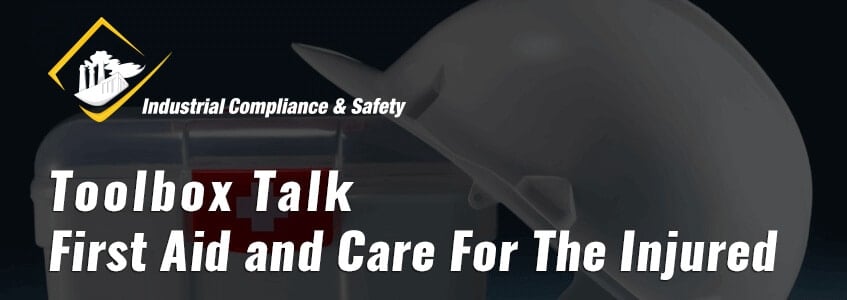It is extremely important for all employees on a worksite to understand the basics of construction site first aid. Contractors and crew members work in a wide variety of dangerous conditions, and they constantly face the risk of falls, being struck by or caught between objects, cuts, burns, and a variety of other injuries (depending on the industry and specific task being performed). If each employee understands jobsite first aid, this results in a safer environment for all involved. Minor injuries can be treated quickly to prevent infection or further strain. Additionally, trained employees can recognize the signs of more serious injuries, and therefore the appropriate aid can be called as soon as possible. Learn more in this discussion guide of first aid requirements on construction sites.
What Are The Most Common Construction Site Accidents?
You’ve most likely heard of the “Fatal Four” in construction site injuries, which make up the four most common categories for injuries in construction. The Fatal Four include:
- Falls
- Electrocution
- Getting caught in construction equipment or machinery
- Being struck by an object
Guidelines for Safety Discussion:
Understanding The Types of Workplace Injuries
Sometimes, it can be difficult to tell whether or not an injury requires professional medical attention, or can be solved with more general training and proper first aid kits in the workplace. Here are some general guidelines to follow when determining the severity of an injury:
- In the case of cuts, you should seek medical attention if the cut:
- Reveals yellow, subcutaneous fatty tissue or bone.
- Cannot be closed by pressing the sides of the skin together.
- Is caused by a contaminated or rusty object.
- Causes bleeding which does not slow after a few minutes.
- Is caused by an impalement (a foreign object is lodged and cannot be easily removed from the skin.In the case of falls or struck by/caught between accidents, you should seek medical attention if any part of the body is severely/abnormally swollen; if the affected part of the body cannot withstand weight; if you hear a cracking or popping noise during the injury; and if the affected part of the body cannot be moved.
- In the case of a head injury, you should seek medical attention if you experience:
- Any change in pupil size.
- Nausea or vomiting.
- Liquid draining from your nose, ears, or mouth.
- Lightheadedness.
- Clumsiness in physical movements or speech.
- Headache or stiff neck.
- Memory loss.
- Bruising on your face.
- If the injured individual loses consciousness at any time, you should ALWAYS seek immediate medical attention.
What To Do If A Workplace Injury Is Serious:
In the case of a serious injury, it is important to remain calm but to move fast. If you follow these steps quickly and accurately, you can minimize the effects of a serious injury and potentially save a life. Here’s what you do step-by-step:
- Contact the appropriate emergency response team(s). As a discussion leader, please include local numbers for paramedics, hospitals, etc.
- Get construction site first aid trained personnel and ask them to help while waiting for emergency response teams to arrive. Do not move the injured person, and prevent the injured person from standing/moving.
- In case of bleeding, apply pressure to the wound until the response teams arrive. Do not use a tourniquet, unless the bleeding is excessive and unaffected by pressure.
- If the injured person has stopped breathing, find someone who has been trained in CPR to help.
- Try to keep the injured person warm.
What To Do If A Workplace Injury Is Not Serious:
If the injury is not serious, that’s better news than a serious injury, but it doesn’t mean you should act any slower. Once again, follow these steps quickly and accurately to minimize the damage the minor injury could cause, as well as a training opportunity when appropriate:
- Contact your supervisor immediately.
- Tell the injured to stay where they are, especially in the case of a fall.
- Get any job site first aid treatment that may be needed. In the case of minor cuts, disinfect the wound, and apply bandages. In the case of minor sprains, apply ice, and wrap the affected area with medical tape. In the case of minor burns, run the affected area under cold water for a few minutes, then apply burn ointment.
- As a discussion leader, take some time here to train employees on how to treat minor injuries. Quickly review each item in your jobsite first aid kit, and describe its intended use.
Final thoughts And Additional Discussion Notes:
To sum up, minor injuries and serious injuries both require quick and accurate communication to make sure someone with the appropriate expertise can be present as soon as possible, though in some cases minor injuries can be resolved without medical professionals. Be sure you’re team is up to date on all construction safety compliance programs and in the case of any injury, you should follow these general guidelines:
- Report all injuries to a supervisor—even minor ones may become major ones, and it is important to have a rough timeline of events if someone’s health takes a turn for the worse. Tell your employees the appropriate supervisor to report injuries and on the job accidents.
- Seek first aid for even minor injuries, and ALWAYS disinfect cuts and scrapes.
- Be sure that emergency telephone numbers and the location of the nearest cross street are posted in a conspicuous place on the job. Save them to your cellphones.
- Keep a construction site First Aid action plan posted in a conspicuous location at all worksites.
- Keep a log of any employees who are officially certified to administer CPR and first aid.
By utilizing these helpful tips, you can help keep your entire team protected and cared for in the event of an accident on the job.
Disclaimer
The information contained within this document (both the online and downloadable version) is provided for informational purposes only. Nobody shall take this as a comprehensive or exhaustive resource on this topic. This material is believed to be accurate, however, the information has been compiled from multiple sources, and so Industrial Compliance & Safety assumes no responsibility for the accuracy of this information. We encourage you to consult experts about this specific Toolbox Talk to ensure you are compliant with any and all safety regulations and processes. In no event does the content of this document supersede any applicable local, state, or federal statutes or regulations.





